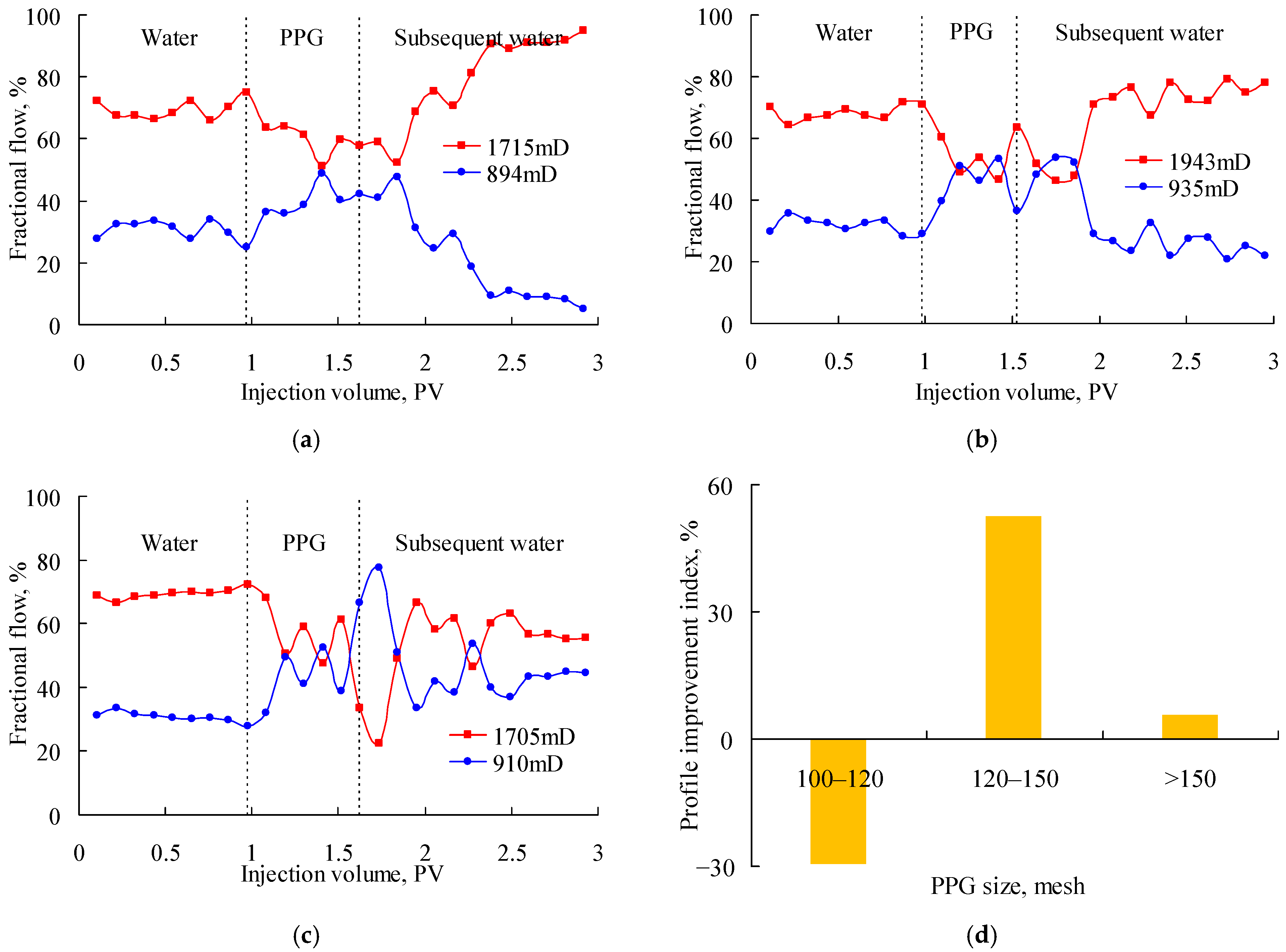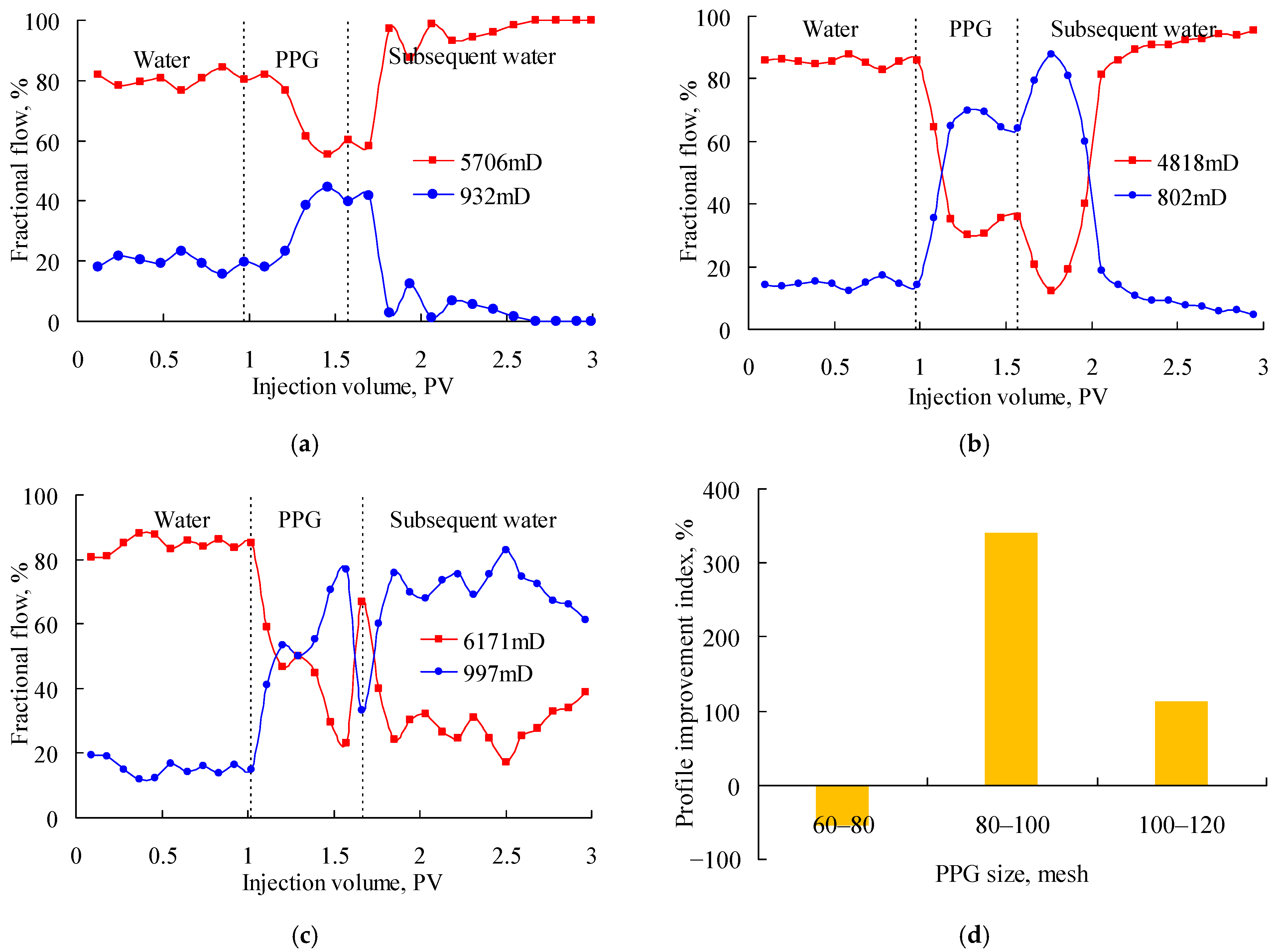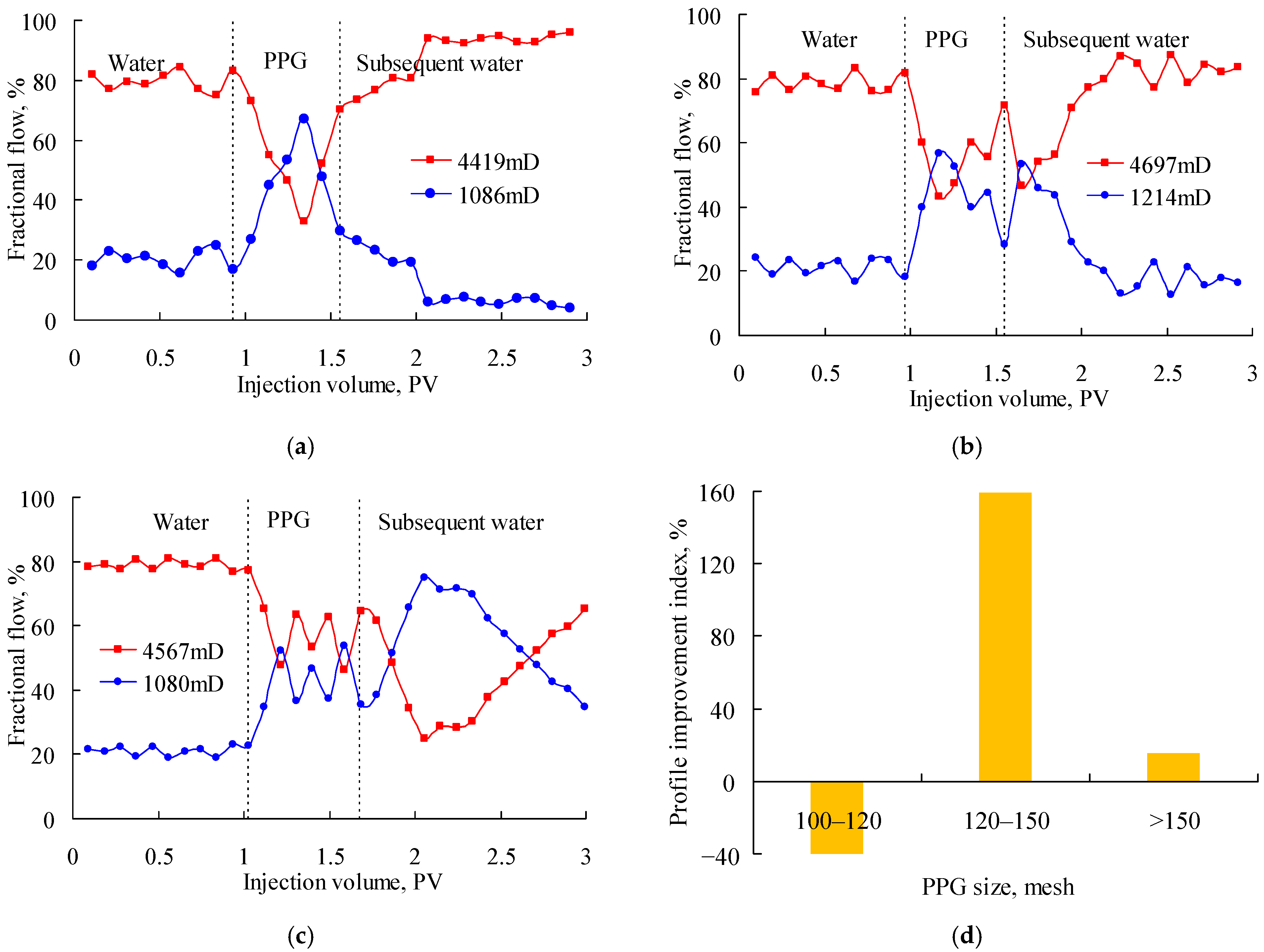Selective Penetration and Profile Control Performance of Preformed Particle Gels for Heterogeneous Oil Reservoirs
Abstract
:1. Introduction
2. Materials and Methods
2.1. Materials
2.2. Experimental Apparatus
2.3. Experimental Procedure
- Prepare the parallel model and measure the porosity and permeability of each sand pack;
- Displace the parallel model successively using about 1 PV of water, 0.6 PV of PPG suspension and, again, 1.4 PV of water;
- Record the injection pressure every 1 min and measure the liquid flux of each sand pack every 10 min;
- Analyze the experimental data and establish the matching relationship between the PPG properties and reservoir heterogeneity.
2.4. Evaluation Criteria
3. Results and Discussion
4. Conclusions and Limitations
- An excessively large PPG or elastic modulus may plug a low-permeability sand pack and even result in a very severe fluid channeling. An excessively small PPG or elastic modulus had a certain degree of profile control, but the PPG could easily migrate out of high-permeability sand packs with subsequent water.
- The best suitable PPG size and elastic modulus increased with the increase of the reservoir permeability ratio. When the elastic modulus was fixed, the best suitable PPG mesh exhibited a linear relationship with the permeability ratio.
Author Contributions
Funding
Institutional Review Board Statement
Informed Consent Statement
Data Availability Statement
Conflicts of Interest
References
- Bai, B.; Li, L.; Liu, Y.; Liu, H.; Wang, Z.; You, C. Preformed particle gel for conformance control: Factors affecting its properties and applications. SPE Reserv. Eval. Eng. 2007, 10, 415–422. [Google Scholar] [CrossRef]
- Moghadam, A.M.; Sefti, M.V.; Salehi, M.B.; Koohi, A.D. Preformed particle gel: Evaluation and optimization of salinity and pH on equilibrium swelling ratio. J. Pet. Explor. Prod. Technol. 2012, 2, 85–91. [Google Scholar] [CrossRef]
- Dai, C.; Zhao, G.; Zhao, M.; You, Q. Preparation of dispersed particle gel (DPG) through a simple high speed shearing method. Molecules 2012, 17, 14484–14489. [Google Scholar] [CrossRef]
- Yang, H.; Kang, W.; Liu, S.; Bai, B.; Zhao, J.; Zhang, B. Mechanism and influencing factors on the initial particle size and swelling capability of viscoelastic microspheres. J. Dispers. Sci. Technol. 2015, 36, 1673–1684. [Google Scholar] [CrossRef]
- Imqam, A.; Bai, B. Optimize the strength and size of preformed particle gels for better conformance control treatment. Fuel 2015, 148, 178–185. [Google Scholar] [CrossRef]
- Saghafi, H.R.; Naderifar, A.; Gerami, S.; Emadi, M.A. Improvement in thermos-chemical stability of nanocomposite preformed particle gels for conformance control in harsh oil reservoir conditions. Can. J. Chem. Eng. 2016, 94, 1880–1890. [Google Scholar] [CrossRef]
- Khoshkar, P.A.; Fatemi, M.; Ghazanfari, M.H. Static and dynamic evaluation of the effect of nanomaterials on the performance of a novel synthesized PPG for water shut-off and improved oil recovery in fractured reservoirs. J. Pet. Sci. Eng. 2020, 189, 107019. [Google Scholar] [CrossRef]
- Bai, B.; Zhang, H. Preformed-particle-gel transport through open fractures and its effect on water flow. SPE J. 2011, 16, 388–400. [Google Scholar]
- Wang, J.; Liu, H.; Wang, Z.; Hou, P. Experimental Investigation on the Filtering Flow Law of Pre-gelled Particle in Porous Media. Transp. Porous Media 2012, 94, 69–86. [Google Scholar] [CrossRef]
- Elsharafi, M.O.; Bai, B. Experimental work to determine the effect of load pressure on the gel pack permeability of strong and weak preformed particle gels. Fuel 2017, 188, 332–342. [Google Scholar] [CrossRef]
- Song, Z.; Bai, B.; Challa, R. Using Screen Models to Evaluate the Injection Characteristics of Particle Gels for Water Control. Energy Fuels 2017, 32, 352–359. [Google Scholar] [CrossRef]
- Imqam, A.; Wang, Z.; Bai, B. The plugging performance of preformed particle gel to water flow through large opening void space conduits. J. Pet. Sci. Eng. 2017, 156, 51–61. [Google Scholar] [CrossRef]
- Saghafi, H.R. Retention characteristics of enhanced preformed particle gels (PPGs) in porous media: Conformance control implications. J. Pet. Sci. Eng. 2018, 166, 962–968. [Google Scholar] [CrossRef]
- Li, J.; Jiang, Z.; Wang, Y.; Zheng, J.; Huang, G. Stability, seepage and displacement characteristics of heterogeneous branched-preformed particle gels for enhanced oil recovery. RSC Adv. 2018, 8, 4881–4889. [Google Scholar] [CrossRef]
- Zhao, G.; Li, J.; Gu, C.; Li, L.; Sun, Y.; Dai, C. Dispersed particle gel strengthened polymer/surfactant as a novel combination flooding system for enhanced oil recovery. Energy Fuels 2018, 32, 11317–11327. [Google Scholar] [CrossRef]
- Zhou, K.; Hou, J.; Sun, Q.; Guo, L.; Du, Q.; Liu, Y. Study on the flow resistance of the dispersion system of deformable preformed particle gel in porous media using LBM-DEM-IMB method. J. Dispers. Sci. Technol. 2019, 40, 1523–1530. [Google Scholar] [CrossRef]
- Sang, Q.; Li, Y.; Yu, L.; Li, Z.; Dong, M. Enhanced oil recovery by branched-preformed particle gel injection in parallel-sand-pack models. Fuel 2014, 136, 295–306. [Google Scholar] [CrossRef]
- Goudarzi, A.; Zhang, H.; Varavei, A.; Taksaudom, P.; Hu, Y.; Delshad, M.; Sepehrnoori, K. A laboratory and simulation study of preformed particle gels for water conformance control. Fuel 2015, 140, 502–513. [Google Scholar] [CrossRef]
- Gong, H.; Zhang, H.; Xu, L.; Li, K.; Yu, L.; San, Q.; Dong, M. The synergistic effect of branched-preformed particle gel and hydrolyzed polyacrylamide on further-enhanced oil recovery after polymer flooding. Energy Fuels 2017, 31, 7904–7910. [Google Scholar] [CrossRef]
- Zhao, W.; Liu, H.; Wang, J.; Zhang, H.; Yao, C.; Wang, L.; Qi, P. Investigation of restarting pressure gradient for preformed particle gel passing through pore-throat. J. Pet. Sci. Eng. 2018, 168, 72–80. [Google Scholar] [CrossRef]
- Sun, X.; Alhuraishawy, A.K.; Bai, B.; Wei, M. Combining preformed particle gel and low salinity water flooding to improve conformance control in fractured reservoirs. Fuel 2018, 221, 501–512. [Google Scholar] [CrossRef]
- Wu, D.; Zhou, K.; Hou, J.; An, Z.; Zhai, M.; Liu, W. Experimental study on combining heterogeneous phase composite flooding and streamline adjustment to improve oil recovery in heterogeneous reservoirs. J. Pet. Sci. Eng. 2020, 194, 107478. [Google Scholar] [CrossRef]
- Zhao, J.; Kang, W.; Liu, J.; Zhang, B. Study on compatibility between preformed particle gel and formation. China Sci. Pap. 2015, 10, 1818–1821. [Google Scholar]
- Dai, C.; Liu, Y.; Zou, C.; You, Q.; Yang, S.; Zhao, M.; Sun, Y. Investigation on matching relationship between dispersed particle gel (DPG) and reservoir pore-throats for in-depth profile control. Fuel 2017, 207, 109–120. [Google Scholar] [CrossRef]
- Wang, D.; Seright, R.S. Examination of literature on colloidal dispersion gels for oil recovery. Pet. Sci. 2021, 18, 1097–1114. [Google Scholar] [CrossRef]
- Bai, B.; Leng, J.; Wei, M. A comprehensive review of in-situ polymer gel simulation for conformance control. Pet. Sci. 2022, 19, 189–202. [Google Scholar] [CrossRef]
- Wu, D.; Zhou, K.; An, Z.; Hou, J. Experimental Study on the Matching Relationship between PPG Size and Reservoir Heterogeneity. In SPE International Heavy Oil Conference and Exhibition; OnePetro: Richardson, TX, USA, 2018; p. 193709. [Google Scholar]








Publisher’s Note: MDPI stays neutral with regard to jurisdictional claims in published maps and institutional affiliations. |
© 2022 by the authors. Licensee MDPI, Basel, Switzerland. This article is an open access article distributed under the terms and conditions of the Creative Commons Attribution (CC BY) license (https://creativecommons.org/licenses/by/4.0/).
Share and Cite
Zhou, K.; Wu, D.; An, Z.; Liu, S. Selective Penetration and Profile Control Performance of Preformed Particle Gels for Heterogeneous Oil Reservoirs. Gels 2022, 8, 601. https://doi.org/10.3390/gels8100601
Zhou K, Wu D, An Z, Liu S. Selective Penetration and Profile Control Performance of Preformed Particle Gels for Heterogeneous Oil Reservoirs. Gels. 2022; 8(10):601. https://doi.org/10.3390/gels8100601
Chicago/Turabian StyleZhou, Kang, Dejun Wu, Zhibin An, and Shuai Liu. 2022. "Selective Penetration and Profile Control Performance of Preformed Particle Gels for Heterogeneous Oil Reservoirs" Gels 8, no. 10: 601. https://doi.org/10.3390/gels8100601



